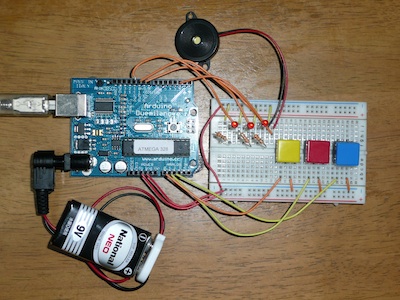[月別過去ログ] 2009年11月
« 2009年10月 | 最新のページに戻る | 2009年12月 »2009年11月27日
■ アンケート集計 / 来年は「身体性の脳内メカニズム」です!
NIPS-SSC workshopのアンケートの集計が終了したのでwebサイトにポストしておきました。PDFファイルにしてあります。全体的に好評だったのでよかったです。ぜひこれを将来につなげていきたいです。

ということでさっそく来年の研究会ですが、もう始動してます。以前のエントリでも書きましたが、日本のミスター・ミラーニューロン、近畿大学の村田哲さん(ラボのwebサイトおよび「脳のセミナー」へのリンク)といっしょにオーガナイズするということで相談を始めています。
タイトルは「身体性の脳内メカニズム」。英語で言うならembodimentです。自己・他者・身体の認知、模倣、共感などの領域で実際に手を動かしている若手の方にしゃべっていただくという方向性で、これまでと同様、議論が活発に出来るような形を目指します。学際的にいきたいので、神経生理学、脳機能イメージング、理論モデル、神経心理、発達心理、動物心理、ロボティクスなどの関連の領域から講演者の方を選考しているところです。学際的にやるときのポイントはどれだけ脳と結びつけることを意識しておられるかという点だと思っているのですが、ともあれご期待下さい。
まだわたしも勉強中ですが、どうやらいちばんの参考図書となるのは「ソーシャルブレインズ 自己と他者を認知する脳」(東大出版)になりそうです。ということで図書館から借りて読んでます。みなさんもぜひ。
さいきんはクリス・フリスの「心を作る」も読んでます。だれかあそこ行って仕事してきた人とかいたら今回のテーマ的にも適任だと思うのですけどね。わたしにとっては身体性とベイズ脳ってのは直結するんで、身体性ってのは周辺領域なんかじゃあなくって、ニューロンのcodingの本質に関わっていると思ってます。ってのがこないだのわたしの「アクティブな知覚」で言おうとしてたことに繋がります。
あー、いま思いついたけど、再来年はBMI、というか操作脳科学でcoding/decodingまで含めたあたりがテーマというのでどうですかね。毎年少しずつオーバーラップしながらテーマを移動させてゆくという意味では悪くないのではないでしょうか。技術的な面よりも、脳情報の活用・制御によって私たちの身体・知覚表象がどのように変わるのかというあたりに焦点を置ければ楽しいと思います。Coding/decodingの議論ができるほど進歩してればなお良いなあ。脳プロと連携しつつも違ったかんじでアプローチできるとよいのですけど。なんてかんじでネタは尽きないね。
話を戻すと、来年の日程は現在のところ10/15(金)-16(土)を予定してます。神経科学大会とSFNの間ということでこれもいつもと同じです。
ともあれ、まだ現在申請作業中ですので、開催できるかどうかは例年3月に確定します。随時レポートしていきたいと思います。ではまた。
追記:事業仕分け関連はいろいろ思うところはあるけど、ここには書かずにTwitterの方だけにしときます。
- / ツイートする
- / 投稿日: 2009年11月27日
- / カテゴリー: [生理研研究会2009「意識の脳内メカニズム」] [生理研研究会2010「身体性の脳内メカニズム」]
- / Edit(管理者用)
2009年11月05日
■ A three-choice reaction time task using Arduino
I have been using Facebook for a while. I imported my blog and it works ok. Now I decided that I will occasionally post some entries in English.
Recently I made a simple reaction time task using Arduino. So it will be a good material to write in English because it may interest English-speaking readers.
Arduino is a set of hardware (with AVR microcontroller) and software (IDE with a simple, C-like language) for physical computing. It is very cheap ($30 hardware and free software) and is very easy to start. If you have an LED, you can run a program to blink the LED within 5 min.
I have been interested in physical computing. But the PIC, the most popular microcontroller, was too difficult for me, with a complicated, assembler-like language.
Recently I read some issues of MAKE magazine and know what arduino is. I bought Arduino Duemilanove, just as a hobby, and played around for a while. I noticed that I can use it for a simple reaction time task, which would be usually built on DAQ + LabView, Matlab or TEMPO. So I started and this is the preliminary result.
As in the figure, Arduino Duemilanove is connected via an USB cable to my PC. A 006P battery is also connected. It works standalone when detached from the USB cable. All of the other parts are plugged into a solderless breadboard. It has three LEDs. From D9-11 pins, an LED and a resistor (330 Ω) are serially connected to the GND pin. A small speaker is connected between the D3 pin and the GND pin. Three buttons are connected between the A0-2 pin and the GND pin.
Now I start arduino IDE on the PC and upload the program 'Reaction_time2.pde'. here is the code. The code is based on a sample program on the arduino web site (Reaction Time Tester).
Then detach the USB cable. It will run standalone. Start the task by pushing the middle button. Then three LEDs flashes. After a variable delay (defined by iti_min and iti_max), one of the LED turns on. Your task is to push the correct button (left button for left LED and so on) as early as possible. If you choose the correct one, the LED turn off with a high tone. If you choose the incorrect one, the LED does not turn off, with a low tone. After 10 trials, three LEDs flashes again and the task terminates.
After the task, reconnect the USB cable and run the program 'Read_score2.pde', which is actually a subset of the 'Reaction_time2.pde'. Here is the code. Then you will get a result like that on the serial monitor of the IDE:
Begin Ready 0 3 959 1 1 1 939 1 2 1 515 1 3 2 530 1 4 3 914 1 5 1 510 0 5 1 732 1 6 1 507 1 7 3 518 1 8 1 434 1 9 2 422 1 56 Completed
The first column: trial number; the second column: target number; the third column: reaction time in ms; the fourth column: correct (=1) or incorrect (=0).
There are a lot of rooms for improvement but I am happy that it looks good enough for replacing some of otherwise bigger systems.
お勧めエントリ
- 細胞外電極はなにを見ているか(1) 20080727 (2) リニューアル版 20081107
- 総説 長期記憶の脳内メカニズム 20100909
- 駒場講義2013 「意識の科学的研究 - 盲視を起点に」20130626
- 駒場講義2012レジメ 意識と注意の脳内メカニズム(1) 注意 20121010 (2) 意識 20121011
- 視覚、注意、言語で3*2の背側、腹側経路説 20140119
- 脳科学辞典の項目書いた 「盲視」 20130407
- 脳科学辞典の項目書いた 「気づき」 20130228
- 脳科学辞典の項目書いた 「サリエンシー」 20121224
- 脳科学辞典の項目書いた 「マイクロサッケード」 20121227
- 盲視でおこる「なにかあるかんじ」 20110126
- DKL色空間についてまとめ 20090113
- 科学基礎論学会 秋の研究例会 ワークショップ「意識の神経科学と神経現象学」レジメ 20131102
- ギャラガー&ザハヴィ『現象学的な心』合評会レジメ 20130628
- Marrのrepresentationとprocessをベイトソン流に解釈する (1) 20100317 (2) 20100317
- 半側空間無視と同名半盲とは区別できるか?(1) 20080220 (2) 半側空間無視の原因部位は? 20080221
- MarrのVisionの最初と最後だけを読む 20071213
